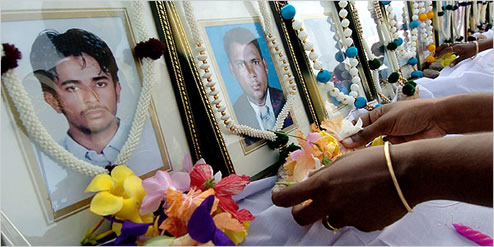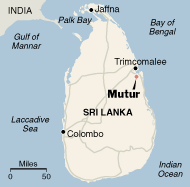
At a memorial service on Aug. 11 in Trincomalee, a mourner put flowers on photos of 17 Action Against Hunger workers killed early this month.
SANGAM.ORG
Ilankai Tamil Sangam, USA, Inc.
Association of Tamils of Sri Lanka in the USA
by Shimali Senanayake and Somini Sengupta, The New York Times, August 31, 2006
|
No other group, the Monitoring Mission concluded, would have been in a position to carry out the killings, which it called a “gross violation” of the tattered cease-fire. “The Security Forces of Sri Lanka are widely and consistently deemed to be responsible for the incident,” the statement read. Such executions are considered a war crime... |
At a memorial service on Aug. 11 in Trincomalee, a mourner put flowers on photos of 17 Action Against Hunger workers killed early this month. |
In a searing indictment of the Sri Lankan government, Swedish-led cease-fire monitors on Wednesday accused government security forces of killing 17 aid workers early this month in Mutur in one of the worst attacks against humanitarian workers worldwide in recent years.

The aid workers were found shot to death in an office in Mutur.
The statement, issued by the Sri Lanka Monitoring Mission, cited three reasons for its conclusion. First, it noted, security forces had been in Mutur at the time of the killings. Second, the government had barred the monitors from the scene immediately after the bodies had been discovered. Third, confidential conversations with “highly reliable sources” had pointed to the culpability of the security forces.
No other group, the Monitoring Mission concluded, would have been in a position to carry out the killings, which it called a “gross violation” of the tattered cease-fire.
“The Security Forces of Sri Lanka are widely and consistently deemed to be responsible for the incident,” the statement read. Such executions are considered a war crime, the New York-based group Human Rights Watch noted in a statement on Aug. 11, referring to the episode.
The 17 employees of the French branch of the international aid agency Action Against Hunger were found dead on Aug. 6 in the agency’s office in Mutur. Fifteen of the employees had been shot in the head. Two had been shot in the back, as though they had been trying to escape their attackers, agency officials said at the time.
They all wore T-shirts bearing the agency’s name. Action Against Hunger worked on tsunami reconstruction and provided water and sanitation services to people displaced by war.
The government has said it would conduct an inquiry, but has made no announcements about its investigation yet.
In a statement, it reacted angrily, saying it “regrets the unprofessional and rather irresponsible stand” by the truce mission. It said the determination lacked any factual evidence to substantiate its conclusion and was based on misleading inferences, denying that the authorities prevented monitors from visiting the scene.
The government “categorically rejects this sweeping generalization of a very speculative conclusion reached even before the necessary forensic and other investigations have been concluded,” the statement added.
The findings of the truce monitors were issued on the eve of the departure of its Swedish chief, Maj. Gen. Ulf Henricsson, and several others who are from European Union countries. The rebel Liberation Tigers of Tamil Eelam demanded that European Union citizens leave the mission after the European Union added the group to its list of banned terrorists in May.
The move effectively forced the ouster of monitors from Denmark, Finland and Sweden. Monitors from Norway and Iceland, non-European Union countries, will remain in Sri Lanka. The size of the mission will shrink by half, to about 30.
The monitors on Wednesday also blamed the rebels for a mine attack on a civilian bus that killed 68 people in June, while holding the government responsible for mine attacks in rebel-held territory from April through June in what it called “a deliberate strategy against’’ rebel cadres and civilians in rebel-controlled areas.
A long-fragile cease-fire agreement, signed in 2002, has since deteriorated to a resumption of conventional warfare between Sri Lankan military and rebel troops.
The latest fighting began about a month ago, ostensibly over control of an irrigation channel in the east, and has since spread to the strategic largely Tamil Jaffna peninsula in the north.
By this week, the fighting had blocked access in and out of Jaffna, leaving it perilously short of food staples. About 200,000 people have been displaced by the latest fighting, the United Nations refugee agency says.
Clashes continued this week, with the Sri Lankan military pounding rebel positions in the east with mortar and artillery fire. The rebels said on Tuesday that 22 Tamil civilians had been killed in troop attacks, a charge the military has denied.
Earlier on Wednesday, an ethnic Tamil journalist who was abducted a day earlier, was freed unharmed. The journalist, Nadaraja Guruparan, 39, who leads the news division of a privately owned Tamil-language radio station Sooriyan FM, had been abducted by an armed group on his way to work.
Five journalists have been killed in the last 16 months, four of them ethnic Tamils. None of the cases have been solved.
Shimali Senanayake reported from Colombo for this article, and Somini Sengupta from New Delhi.
© 1996-2025 Ilankai Tamil Sangam, USA, Inc.